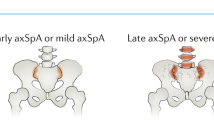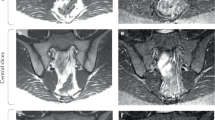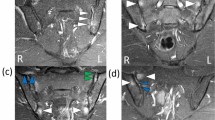Abstract
New classification criteria for axial spondyloarthritis (SpA) have been developed and validated. MRI of the sacroiliac joints is an important feature in these criteria. This is rightfully so, as MRI can identify active lesions in the subchondral bone marrow that are thought to be related to the underlying pathophysiological process at the cartilage–bone junction. Follow-up studies using various imaging techniques, including MRI, in unselected patients with undiagnosed back pain of short symptom duration will provide more information on the differential diagnostic capacity of MRI and its predictive value for long-term outcomes. Even longer-term follow-up (>10 years) is necessary to provide reliable data; however, the validity of MRI in the diagnostic process can only be approximated, as it will never cover the entire gestalt of SpA.
This is a preview of subscription content, access via your institution
Access options
Subscribe to this journal
Receive 12 print issues and online access
$209.00 per year
only $17.42 per issue
Buy this article
- Purchase on Springer Link
- Instant access to full article PDF
Prices may be subject to local taxes which are calculated during checkout
Similar content being viewed by others
References
De Rycke, L., Maas, M., Tak, P. P. & Baeten, D. 'MRI-tis' in the early diagnosis of axial SpA: issues and limitations. Nat. Rev. Rheumatol. doi:10.1038/nrrheum.2010.161.
Rudwaleit, M. et al. The development of Assessment of SpondyloArthritis International Society (ASAS) classification criteria for axial spondyloarthritis (part I): classification of paper patients by expert opinion including uncertainty appraisal. Ann. Rheum. Dis. 68, 770–776 (2009).
Rudwaleit, M. et al. The development of Assessment of SpondyloArthritis International Society (ASAS) classification criteria for axial spondyloarthritis (part II): validation and final selection. Ann. Rheum. Dis. 68, 777–783 (2009).
Mau, W. et al. Evaluation of early diagnostic criteria for ankylosing spondylitis in a 10 year follow-up. Z. Rheumatol. 49, 82–87 (1990).
Rudwaleit, M., Khan, M. A. & Sieper, J. The challenge of diagnosis and classification in early ankylosing spondylitis: do we need new criteria? Arthritis Rheum. 52, 1000–1008 (2005).
Maksymowych, W. P. Ankylosing spondylitis—at the interface of bone and cartilage. J. Rheumatol. 27, 2295–2301 (2000).
Rudwaleit, M. et al. Defining active sacroiliitis on magnetic resonance imaging (MRI) for classification of axial spondyloarthritis: a consensual approach by the ASAS/OMERACT MRI group. Ann. Rheum. Dis. 68, 1520–1527 (2009).
van Tubergen, A. et al. Radiographic assessment of sacroiliitis by radiologists and rheumatologists: does training improve quality? Ann. Rheum. Dis. 62, 519–525 (2003).
Author information
Authors and Affiliations
Contributions
D. van der Heijde and M. Rudwaleit researched data for the article. All authors made substantial contributions to discussion of content. D. van der Heijde wrote the article. All authors were involved in review/editing of the manuscript before submission.
Corresponding author
Ethics declarations
Competing interests
The authors declare no competing financial interests.
Rights and permissions
About this article
Cite this article
van der Heijde, D., Rudwaleit, M., Landewé, R. et al. Justification for including MRI as a tool in the diagnosis of axial SpA. Nat Rev Rheumatol 6, 670–672 (2010). https://doi.org/10.1038/nrrheum.2010.160
Published:
Issue Date:
DOI: https://doi.org/10.1038/nrrheum.2010.160
This article is cited by
-
Comparative analysis of the diagnostic values of T2 mapping and diffusion-weighted imaging for sacroiliitis in ankylosing spondylitis
Skeletal Radiology (2020)
-
Diagnosis and classification in spondyloarthritis: identifying a chameleon
Nature Reviews Rheumatology (2012)
-
Osteoimmunology and osteoporosis
Arthritis Research & Therapy (2011)



